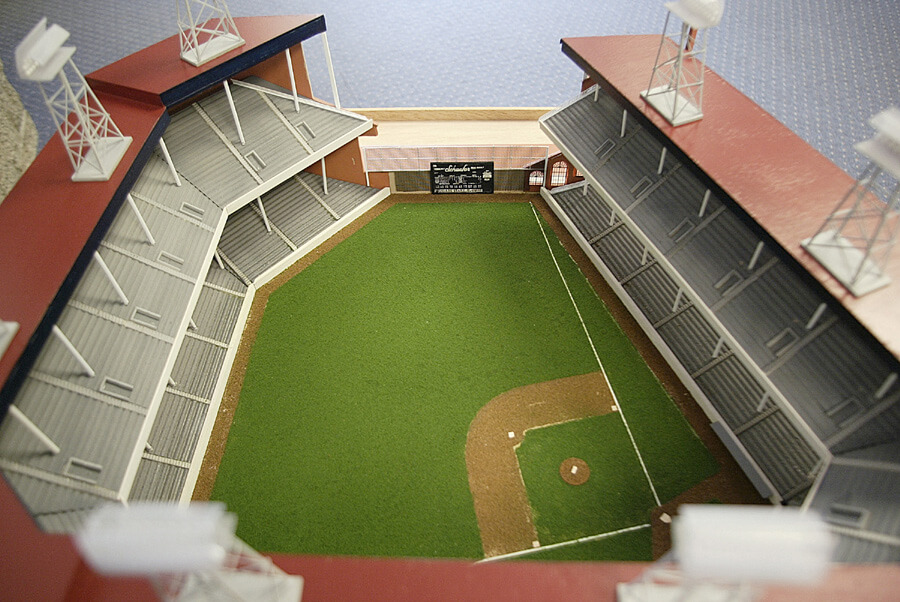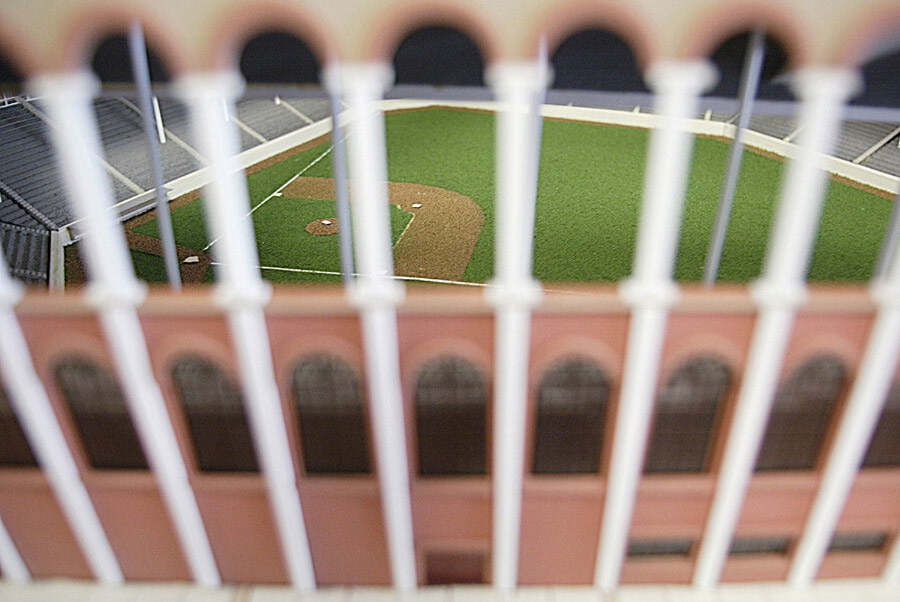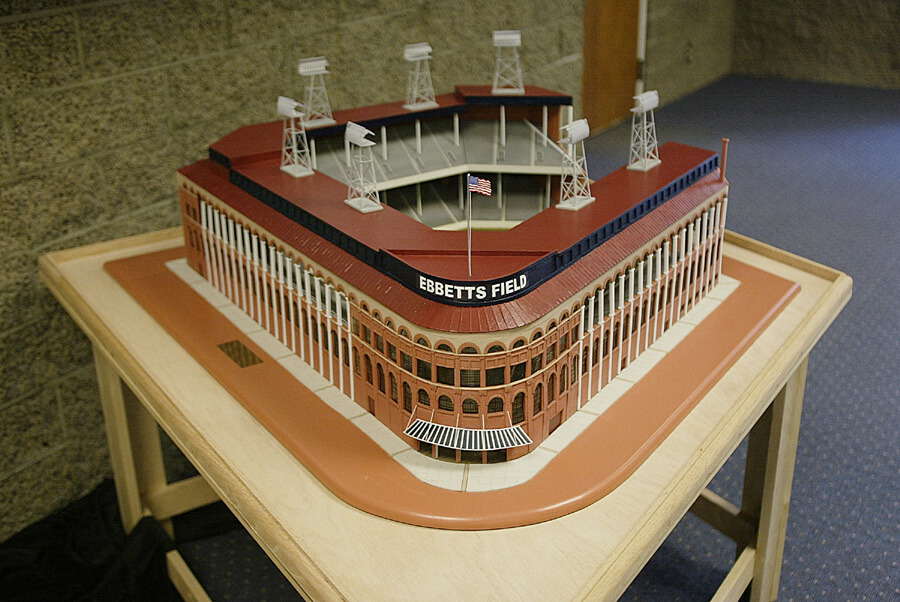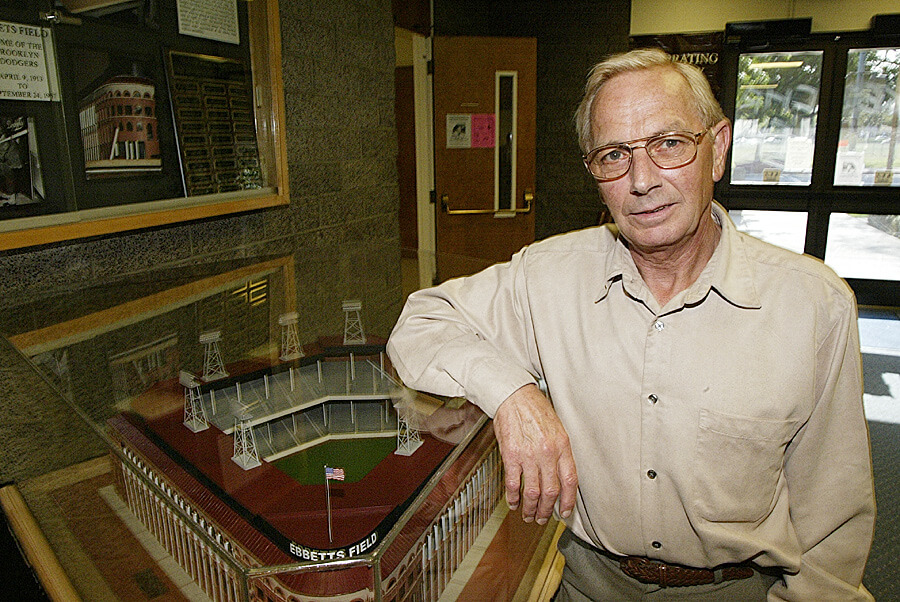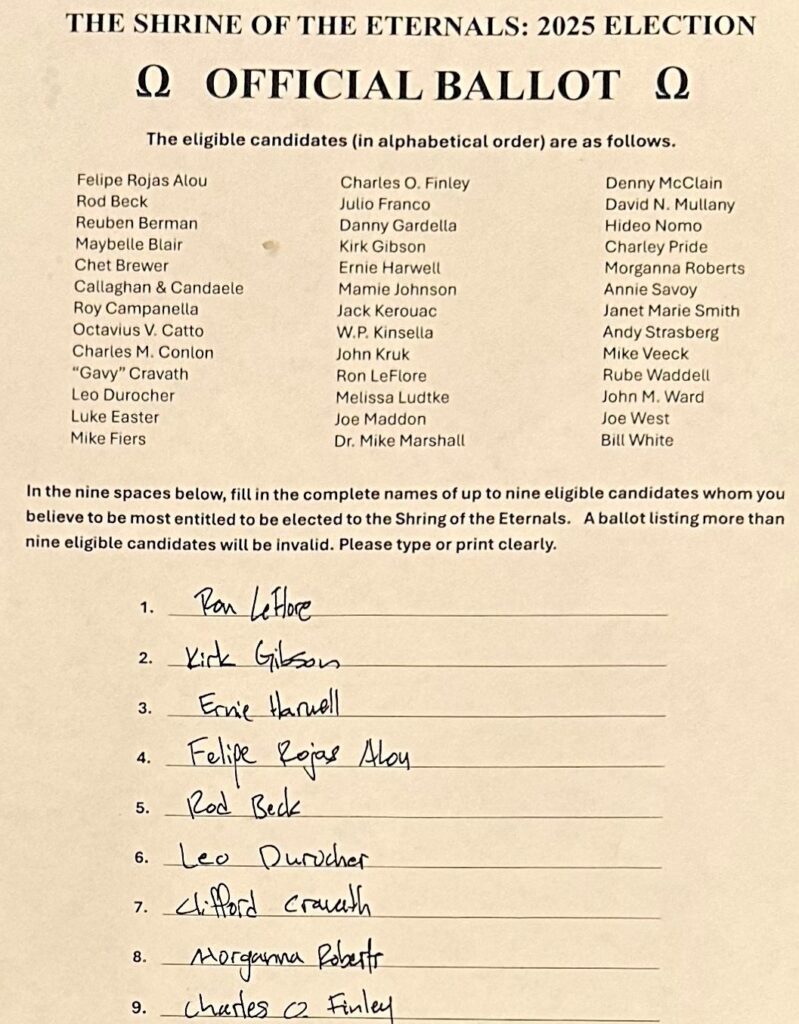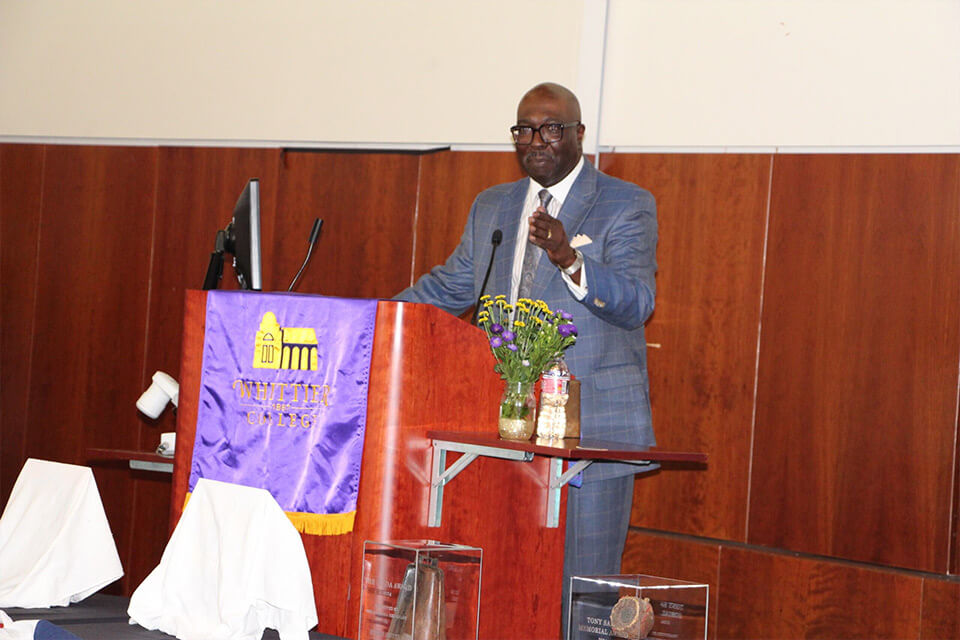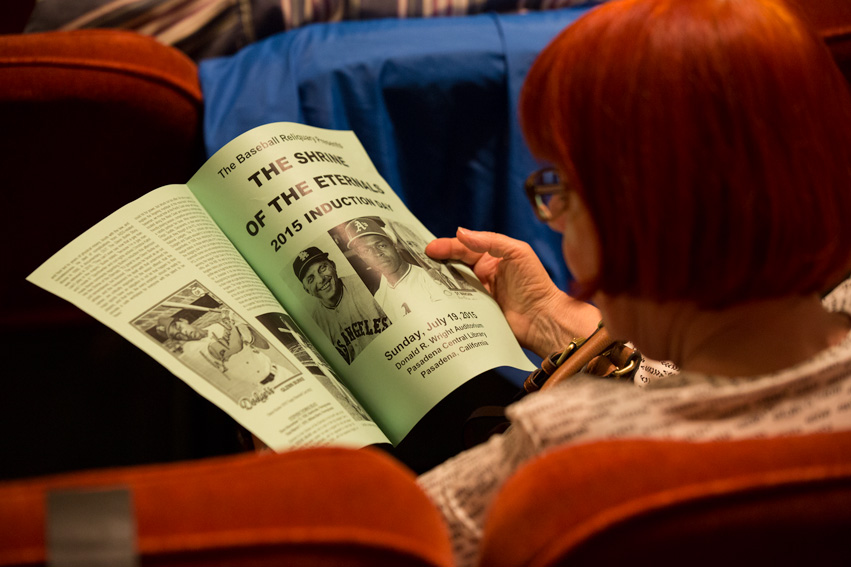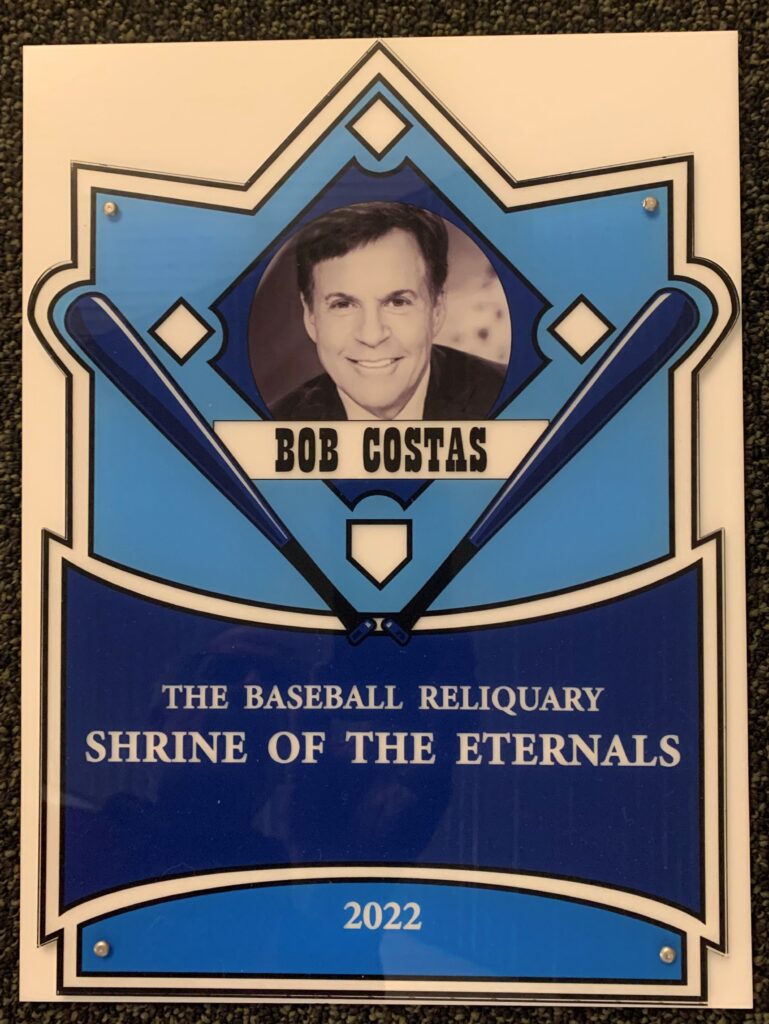The Baseball Reliquary Presents
William Robert Steele’s
Ebbets Field Replica
At The Jackie Robinson Center
1020 N. Fair Oaks Ave., Pasadena, California
The Baseball Reliquary’s Ebbets Field replica was dedicated during a special ceremony on May 11, 2002 at the City of Pasadena’s Jackie Robinson Center , where it will be on exhibit indefinitely. Nearly 100 people attended the unveiling, which was preceded by a program of guest speakers discussing a variety of historical topics related to Ebbets Field and the players who performed there. The roster of speakers included Peter Dreier, Ray Bartlett, Andy McCue, and Michael C. Ford.
The E.P. Clapp Distinguished Professor of Politics and Director of the Urban and Environmental Policy Program at Occidental College in Los Angeles, Peter Dreier addressed the cultural legacy of Jackie Robinson. (The Jackie Robinson Center is just blocks away from the former site of Robinson’s childhood home in Pasadena.) He told an anecdote about how he talked his parents, both lifelong Democrats, into taking him to a Richard Nixon rally in his New Jersey hometown in 1960 for the sole purpose of meeting his boyhood idol, Jackie Robinson. Robinson’s decision to campaign for Nixon, whom he felt would be more supportive of the civil rights movement than John F. Kennedy, was one he would later regret. Dreier argued persuasively that the City of Pasadena needs to build a permanent educational exhibit to help enshrine Robinson’s place in local and national history and that the Pasadena Unified School District should incorporate Robinson’s story into the regular curriculum.
Ray Bartlett, a lifelong friend of Jackie Robinson, reminisced about some of their experiences growing up together in Pasadena. The two played side-by-side on the football, basketball, baseball, and track teams at Pasadena Junior College and UCLA. While at the latter school, Bartlett introduced Jackie to his future wife, Rachel, and he still maintains his link to Jackie by participating on the UCLA Jackie Robinson Scholarship Committee.
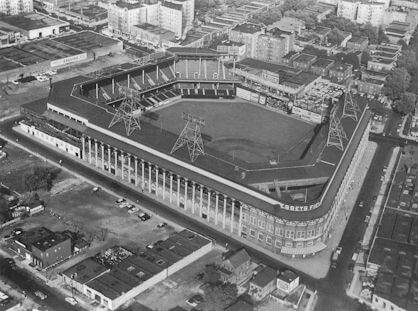 Baseball historian Andy McCue, an economics consultant based in Riverside, California who is currently writing a biography of Walter O’Malley, provided interesting historical details on Charles Ebbets and the ballpark that bore his name. Discussing how Ebbets Field reflected the changing stability and economics of baseball, McCue noted that the concrete and steel stadium opened in Brooklyn in 1913 during a period in which many major league owners began replacing their cheaply constructed wooden facilities, many of which had crumbled, collapsed, or burned. According to McCue, the construction of new ballparks such as Ebbets Field signified the fact that baseball had entered an important period of prosperity and maturity as a sport.
Baseball historian Andy McCue, an economics consultant based in Riverside, California who is currently writing a biography of Walter O’Malley, provided interesting historical details on Charles Ebbets and the ballpark that bore his name. Discussing how Ebbets Field reflected the changing stability and economics of baseball, McCue noted that the concrete and steel stadium opened in Brooklyn in 1913 during a period in which many major league owners began replacing their cheaply constructed wooden facilities, many of which had crumbled, collapsed, or burned. According to McCue, the construction of new ballparks such as Ebbets Field signified the fact that baseball had entered an important period of prosperity and maturity as a sport.
No program concerning the Brooklyn Dodgers could possibly be complete without some mention of the interesting personalities who regularly frequented Ebbets Field. To this end, Los Angeles-based poet Michael C. Ford, who received a Pulitzer Prize nomination for his volume of selected works from 1970 through 1995, spoke about Marianne Moore, the celebrated modernist poet and recipient of virtually every major American literary award. Moore lived in Brooklyn, where she worked as a librarian and valiantly rooted for the Dodgers. Ford concluded his biographical remarks by reading Moore’s tribute to the Dodgers, entitled “Hometown Piece for Messrs. Alston and Reese.”
Immediately following the formal program, the Ebbets Field replica was unveiled. Confectionery artist William Robert Steele, a graduate of the Baking School of Technology in Belfast, Northern Ireland, constructed the replica under commission from the Baseball Reliquary. Begun in the fall of 2001, the replica was originally to be made entirely of cake icing. For reasons of structural rigidity and longevity, however, Steele used a variety of materials in its construction, including wood, plastic, cement, potter’s clay, pastillage (a combination of powdered sugar, gelatin, and wine vinegar), and royal icing. Although Steele worked exclusively from photographs in building the model, the detail is extraordinary, even incorporating authentic touches such as the scoreboard in right field with clothier Abe Stark’s famous advertisement: “Hit Sign Win Suit.” The approximate dimensions of the replica are 50” x 39” x 34” x 43” (and 15” high).
Dedicated in memory of beloved Brooklyn Dodgers fan Hilda Chester and the immortal Jackie Robinson, the Ebbets Field replica is housed in a specially-constructed Plexiglas case, which includes a baseball signed by the artist, William Robert Steele. A fascinating aside to this project is that when Steele signed the baseball on May 11, 2002 for inclusion with the exhibit, it was the first time he had ever touched a baseball in his life. In fact, Steele had never attended a baseball game of any kind at the time of the dedication. His primary interest in Ebbets Field was more in its uniqueness as an architectural structure than its importance in baseball history.
The Ebbets Field replica is on exhibit indefinitely at the Jackie Robinson Center, along with a display of Jackie Robinson paintings and photographs sponsored by the Baseball Reliquary. Included is artist Michael Guccione’s celebrated “Jackie Robinson Icon.” Located at 1020 N. Fair Oaks Avenue in Pasadena, California, the Jackie Robinson Center is open Monday through Thursday from 8:00 AM to 9:00 PM and Friday from 8:00 AM to 5:00 PM; closed Saturday and Sunday. For directions to the Center, phone (626) 744-7300.
Color Photographs Courtesy of Larry Goren.

